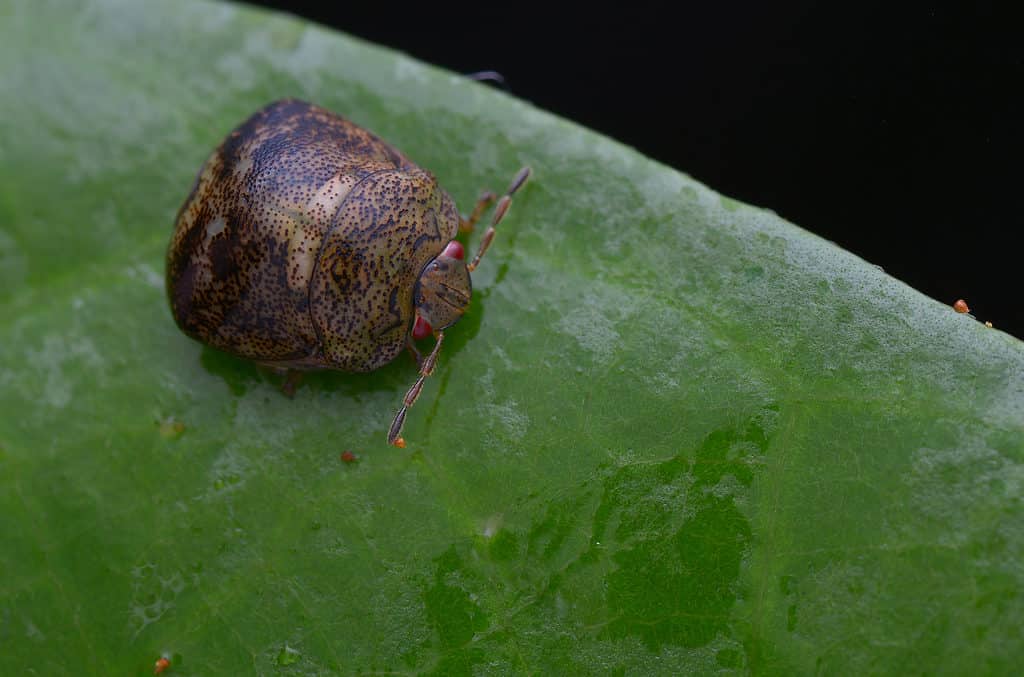Kudzu Bug
Megacopta cribraria
Kudzu bugs don't bite humans, but they secrete a substance that can irritate people's skin. That irritation is often confused for a bite.
Advertisement
Kudzu Bug Scientific Classification
- Kingdom
- Animalia
- Phylum
- Arthropoda
- Class
- Insecta
- Order
- Hemiptera
- Family
- Plataspidae
- Genus
- Megacopta
- Scientific Name
- Megacopta cribraria
Read our Complete Guide to Classification of Animals.
Kudzu Bug Conservation Status
Kudzu Bug Facts
- Name Of Young
- Nymph
- Group Behavior
- Infestation
- Fun Fact
- Kudzu bugs don't bite humans, but they secrete a substance that can irritate people's skin. That irritation is often confused for a bite.
- Biggest Threat
- Pesticides
- Most Distinctive Feature
- Oval-shaped body
- Other Name(s)
- Bean plataspid and lablab bug.
- Habitat
- Kudzu and soybean plants near residential areas
- Predators
- Green Lacewings, And Lady Beetles, Big-eyed Bugs, Damsel Bugs
- Diet
- Herbivore
- Lifestyle
- Diurnal/Nocturnal
- Favorite Food
- Kudzu plants
- Common Name
- Kudzu Bug
- Origin
- Asia
- Average Clutch Size
- 30
View all of the Kudzu Bug images!
The kudzu bug is one of the biggest agricultural pests of beans and legumes. However, many people know them by the name “globular stink bug.” But they go by many names like bean plataspid and lablab bug.
These tiny olive-colored bugs originate from India and China, but they were first documented in the USA in 2009. Researchers believe these kudzu bugs traveled on a plane from Asia to Atlanta and spread ferociously across Georgia, South Carolina, and North Carolina.
If the kudzu bug only feeds on kudzu, it can be pretty beneficial, but when they set their sites on other crops like soybean plants, they can cause mass destruction.
Although they are not dangerous to people or houseplants, they can become a big problem if they enter a home.
Kudzu Bug Scientific Name
The kudzu bug’s scientific name is Megacopta cribraria, and they belong to the order Hemiptera. This order consists of a group of large insects, with about 7500 species around the world and 1,700 species in the British Isles alone.
While most of the species in this order differ from each other, all of them have piercing mouthparts that they use to suck out the juices of plants or blood from animals. In addition, their mouthparts are lodged inside a beak (rostrum), primarily held underneath their bodies when they are not using it.
These pests are members of the Family Plataspidae, usually oval in shape, with a small head, large scutellum, U-shaped abdomens, and forewings larger than their bodies. In addition, there are around 500 species belonging to the Plataspidae family worldwide.
Appearance: How To Identify the Kudzu Bug

Another macro shot of a kudzu bug.
©SIMON SHIM/Shutterstock.com
The kudzu bug has a hard exoskeleton and is usually brown-olive green in color, covered in brown speckles. It is very hard to misidentify these tiny pets because they have a unique oval shape that is broader at the bottom than the top. In addition, they have very distinguished plates on their backs.
Furthermore, like many true bugs, kudzus have piercing mouthparts, which they use to suck out the sap or other fluids from plants and animals. An adult can grow to q/4 inch in length, similar to the size of a lady beetle.
Habitat: Where to Find the Kudzu Bug
Kudzu bugs disperse in large numbers in the early summer months after wintering in tree bark, cracks, garden debris, and doorframes of homes. However, these insects usually inhabit and live off kudzu and soybean plants near residential areas.
In addition, they are attracted to light-colored surfaces like white house siding, white cars, and white clothes!
Diet: What Does the Kudzu Bug Eat?
Kudzu bugs cause extensive damage by feeding on kudzu plants, soybean fields, and other legumes. But they don’t just feed off these plants, they also lay their eggs on them, and their nymphs will start to feed their juices as soon as they hatch.
Feeding on the plants’ nutrients, foliage, and moisture severely damages the crop. In addition, these pesky bugs also feed off peanuts, peas, wisterias, and garden beans.
Life Cycle of the Kudzu Bug
The kudzu bug is a hemimetabolous insect, meaning they complete its life cycle via incomplete metamorphosis. These pests develop in three stages:
Egg
These insects complete one to two generations each year. First, the female will lay her eggs on kudzu leaves, wisteria, or soybean plants. Then, she disperses them in two side-by-side rows, each containing around 15 eggs.
Underneath the kudzu bug eggs are capsules of endosymbiotic bacteria, so once the nymphs hatch, they need to consume this to help digest the host plant.
Nymphs
The kudzu bug nymph phase consists of 5 stages. These nymphs have a hairy appearance and differ in color from a pale orange, olive green, or light brown. kudzu nymphs take approximately 6 to 8 weeks to develop into adults.
Adults
Kudzu bug adults will take refuge in homes during winter, often flocking to the attics for warmth. But, they will inhabit leaf litter or tree bark if they can’t find a cozy home. Then, as the weather starts to warm up, these adults will resume feeding and reproduction.
Adult kudzu bugs can live for around 23 to 77 days, depending on nutritional intake, location, and temperature.
Is the Kudzu Bug Dangerous to Humans?
These bugs don’t bite humans, but they secrete a substance that can irritate people’s skin, which is often confused for a bite.
If this pest does cause skin irritability, it will leave a stain, which will subside after a few days. So, be on the lookout for these tiny bugs in the fall, as they tend to seek shelter in homes when cold weather arises.
Prevention: How to Get Rid of the Kudzu Bug
Unfortunately, there are very few ways to prevent these tiny pests from invading your home. However, there are precautions you can take that might help. For example, kudzu bugs generally infest areas with a lot of food sources, so removing any Kudzy vines surrounding your property could help reduce the likelihood of infestation.
In addition, these bugs also like to feed on wisterias and legumes like beans or peas, so if you have any of these plants in close proximity to your home, getting rid of them can help.
However, preventing kudzu bugs from getting into your home might be more difficult. You can start by meticulously sealing all the gaps on the exterior of your house, especially around the doors and windows. In addition, inspect the vents, pipe openings, and foundation for any cracks or crevices.
How to Get Rid of Kudzu Bugs
There are several ways of getting rid of kudzu bugs; they include:
Removing the Bugs Manually
If you find kudzu bugs in your home, you can vacuum them up with a hose attachment. However, you need to get rid of them while they are still in the bag by putting them in the freezer or submerging them in hot, soapy water, which will kill these pests.
But, whatever you do, do not squish these insects; they will secrete hideous odor and leave a stain on your surfaces.
Spraying Adults
There are several household spray pesticides that will terminate kudzu bugs. However, it might be hard to reach the bugs with these pesticides as they generally congregate high on exterior walls.
When spraying kudzu bugs, you need to use pyrethrin-based pesticides like:
- Bifenthrin
- Lambda-cyhalothrin
- Permethrin
In fact, pesticides ending in a “thrin” contain pyrethrin-based products.
While these pesticides aren’t harmful to people and pets, they are toxic to fish and other aquatic wildlife, so do not pour them down the drain or any place running off into storm drains.
Spraying Nymphs
While spraying adult kudzu bugs is effective, researchers believe spraying the nymphs is even more effective. Commercial soybean farmers prefer this method and tend to use bifenthrin as their pesticide of choice.
So, if you have wisteria or green beans in your garden, give them a good spray during nymph hatching season, which occurs in late May, or early June.
Hire a Professional
For inexperienced gardeners, it might be best to call an exterminator. These trained professionals have all the know-how and tools to terminate those pesky kudzu bugs.
Unfortunately, you may have to call them out more than once because, usually, kudzu bug infestations require several weekly treatments before you see effective results.
Related Articles…
- Are Stink Bugs Dangerous?
- 10 Incredible Dung Beetle Facts
- 9 of the Most Dangerous Insects in the World
Kudzu Bug FAQs (Frequently Asked Questions)
How did the kudzu bug get to the United States?
Researchers believe these kudzu bugs traveled on a plane from Asia to Atlanta and spread ferociously across Georgia, South Carolina, and North Carolina.
Does kudzu irritate skin?
Kudzu bugs don’t bite humans, but they secrete a substance that can irritate people’s skin, which is often confused for a bite.
Are kudzu bugs pests?
The kudzu bug is one of the biggest agricultural pests of beans and legumes. However, many people know them by the name “globular stink bug.” They go by many names, though, like bean plataspid and lablab bug.
Thank you for reading! Have some feedback for us? Contact the AZ Animals editorial team.


















